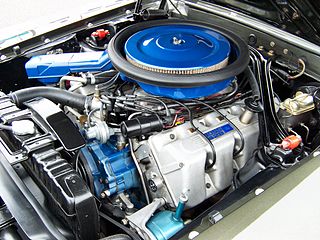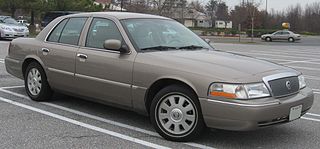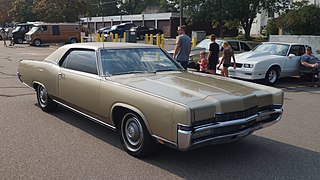
An automatic transmission is a multi-speed transmission used in motor vehicles that does not require any input from the driver to change forward gears under normal driving conditions. Vehicles with internal combustion engines, unlike electric vehicles, require the engine to operate in a narrow range of rates of rotation, requiring a gearbox, operated manually or automatically, to drive the wheels over a wide range of speeds.

The Ford 385 engine family is a series of big block V8 engines designed by Ford Motor Company. The family derives its name from the 3.85-inch (98 mm) crankshaft stroke of the 460 cubic-inch V8 introduced in 1968. A 429 cu in (7.0 L) version was also introduced the same year, with a 370 cu in (6.1 L) variant appearing in 1977.

The Ford small-block is a series of 90° overhead valve small block V8 automobile engines manufactured by the Ford Motor Company from July 1961 to December 2000.

The Ford Modular engine is Ford Motor Company's overhead camshaft (OHC) V8 and V10 gasoline-powered small block engine family. Despite popular belief that the Modular engine family received its moniker from the sharing of engine parts across numerous Ford vehicle platforms, in reality, the Modular engine family was named as such by Ford Motor Company for the new "modular approach" to the setup of tooling and casting stations in the Windsor and Romeo engine manufacturing plants.

The Mercury Grand Marquis is an automobile that was sold by Mercury from 1975 to 2011. Introduced as the flagship sub-model of the Mercury Marquis, the Grand Marquis became a stand-alone model line for 1983, serving as the largest Mercury sedan. Subsequently, the model line would serve as the sedan counterpart of the Mercury Colony Park station wagon; it would later serve as the basis of the revived Mercury Marauder.

The Essex V6 is a 90° V6 engine family built by the Ford Motor Company at the Essex Engine Plant in Windsor, Ontario, Canada. This engine is unrelated to Ford's British Essex V6. Introduced in 1982, versions of the Essex V6 engine family were used in subcompact through to large cars, vans, minivans, and some pickup trucks. The Essex V6 was last used in the 2008 regular-cab F-150, after which it was succeeded by a version of the Ford Cyclone engine. An industrial version of the engine was available until 2015.

TorqueFlite is the trademarked name of Chrysler Corporation's automatic transmissions, starting with the three-speed unit introduced late in the 1956 model year as a successor to Chrysler's two-speed PowerFlite. In the 1990s, the TorqueFlite name was dropped in favor of alphanumeric designations, although the latest Chrysler eight-speed automatic transmission has revived the name.
Ford-O-Matic was the first automatic transmission widely used by Ford Motor Company. It was designed by the Warner Gear division of Borg Warner Corporation and introduced in 1951 model year cars, and was called the Merc-O-Matic when installed in Mercury branded cars and Turbo-Drive when installed in Lincoln branded cars. In contrast to Detroit Gear Division's three band automatic originally designed for Studebaker which became superseded by this unit, a variation of Warner Gear's three-speed unit named Ford-O-Matic continued to evolve later into Cruise-O-Matic named transmissions in 1958 and finally the FMX named transmissions in 1968. This line continued in production until 1980, when the AOD was introduced. Like Ford, variations of this same Borg Warner design were used by other automobile manufacturers as well, such as AMC, International Harvester, Studebaker, Volvo and Jaguar, each of them having the necessary unique adaptations required for the individual applications.
The Ford C6 is a heavy-duty automatic transmission built by Ford Motor Company between 1966 and 1996. It was marketed as the "SelectShift Cruise-O-Matic". Compared to its predecessor MX transmission, the C6 offered lower weight, less complexity, less parasitic power loss, and greater torque capacity for larger engines. It did this without exceeding the packaging dimensions of the MX. These design goals were in line with those of the C4 for smaller engines. It was given the name "SelectShift" because if the transmission was placed in first or second gear, the transmission would use only the gear selected, whether from a standing stop or in motion. This was very helpful when driving in limited traction situations, where the torque of the engine would gradually move the vehicle, or if engine braking was needed on a downward incline. Once the transmission was placed in third, all three gears would be used in a normal fashion.

The Mercury Marquis is a model line of automobiles marketed by Mercury from 1967 to 1986. Deriving its name from a French nobility title, the Marquis was introduced as the divisional counterpart of the Ford LTD; four generations of the two model lines were paired through rebranding. Initially slotted as the flagship Mercury full-size range, the Marquis would serve as the basis for the later Mercury Grand Marquis.
The Ford C4 is a three-speed, medium-duty automatic transmission introduced on 1964 model year vehicles and produced through 1981. The C4 was designed to be a lighter and simpler replacement for the original Ford-O-Matic two speed transmission being used in smaller, less powerful cars.
The TREMEC T-5 is a 5-speed manual transmission for longitudinal engine automobiles. It includes one overdrive gear, a lightweight aluminum housing, and adaptability for four wheel drive use. It is currently manufactured by TREMEC.
The AXOD was a 4-speed automatic transaxle for transverse front wheel drive automobiles from the Ford Motor Company. It was introduced in the 1986 Ford Taurus/Mercury Sable. The AXOD and its successors are built in Ford's Van Dyke Transmission plant in Sterling Heights, Michigan. Production of the final member of the family, the 4F50N, ended in November 2006.
The 6R is a six-speed automatic transmission for longitudinal engine placement in rear-wheel drive vehicles. It is based on the ZF 6HP26 transmission and is built under license by the Ford Motor Company at its Livonia Transmission plant in Livonia, Michigan. The 6R debuted in 2005 in the 2006 model year Ford Explorer and Mercury Mountaineer.
The Ford C3 transmission and its descendants are a family of light-duty longitudinal automatic transmissions built by the Ford Motor Company.

The third-generation Mustang was produced by Ford from 1979 until 1993. Built on Ford's Fox platform, it is commonly referred to as the Fox body Mustang. It evolved through several sub-models, trim levels, and drivetrain combinations during its production life. It underwent updates for the 1987 model year and seemed destined for replacement with a front-wheel drive Mazda platform. However, company executives were swayed by consumer opinion and the rear-wheel drive Mustang stayed, while the front-wheel drive version was renamed the Ford Probe. Enthusiasts group the generation into two segments: the 1979–1986 cars, with their quad headlight arrangement, and the 1987–1993 cars, with their aerodynamic composite headlamps and front fascia styling. Production ended with the introduction of the fourth-generation Mustang (SN-95) for the 1994 model year.

The eleventh generation of the Ford F-Series, also known in Mexico as the Ford Lobo, is a line of light-duty trucks manufactured by Ford from the 2004 to 2008 model years. Slotted between the Ford Ranger and the Ford (F-Series) Super Duty trucks, the model line includes the Ford F-150 pickup truck. Both the body and chassis had undergone a redesign.
The Mercedes-Benz first series of automatic transmission was produced from 1961 to 1983 in four- and three-speed variants for Mercedes-Benz passenger cars. In addition, variants for commercial vehicles were offered.

Mercon is the trade name for a group of technical specifications of automatic transmission fluid created by Ford. The name is a registered trademark of Ford, which licenses the name and specifications to companies that manufacture the fluid and sell it under their own brand names.










